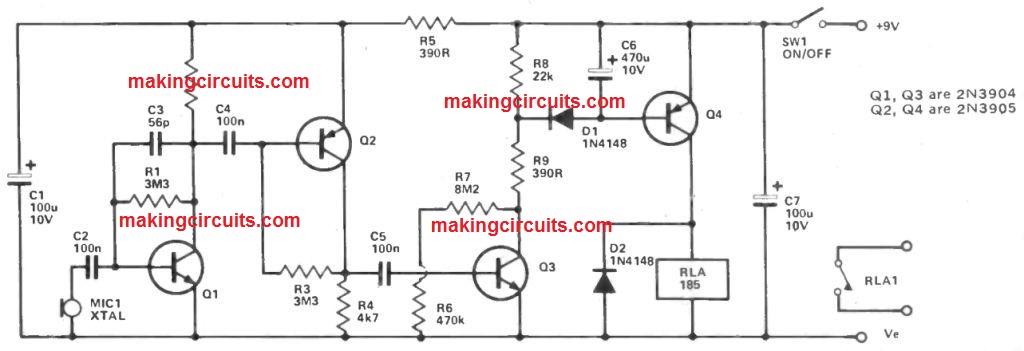Sound triggered switches are employed in several applications, a few common illustrations being voice controlled tape recorders, baby alarms, burglar alarm systems, and VOX (voice managed switching) techniques of radio transmitting/receiving installations.
The straightforward sound operated switch circuit demonstrated here will probably work at a distance of up to around 2 or 3 metres from a voice of average volume (slightly-less in case the xtal microphone insert is substituted with a medium or high impedance powerful sort).

Signals generated by the microphone are amplified by a high gain amplifier which employs two stages of common emitter amplification. These two stages depend on Q1 and Q2 and work with a simple capacitively combined set up.
Both transistors are controlled at low collector currents so as to provide a low noise level and quiescent current usage. C3 rolls off the high frequency response of the circuit and assists great firmness.
The output from Q2 is connected to a third common emitter stage through C5. This third stage is dependent on Q3, and is biased by R6 and R7 to a point where Q3 is practically cut off.
There is hence hardly any voltage produced around load resistor R8, and the input voltage fed to Q4 through D1 is inadequate to switch on this device and trigger the relay which often forms its collector load.
Nevertheless, when sounds are obtained through the microphone, a sturdy signal is acquired at Q3's base, leading to it to perform intensely on positive going input half cycles.
This constitutes a series of powerful negative pulses across C4, charging up this component to a sufficient level to turn on Q4 and the relay.
A set of relay contacts are applied to regulate the supply to the slave devices. C4 charges through the pretty low impedance of Q3 and R9, supplying the circuit pretty quick attack time. C4's release path is with the fairly high impedance of Q4's base emitter junction providing an decay time of a second or two.
Hence the sound operated switch circuit reacts swiftly each time a signal is at first obtained, however the relay will not cut out during the brief pauses that take place while in regular speech.
The consumption of circuit's quiescent current is just around 250 uA, however this increases to around 35mA once the relay is triggered.

Martin says
Thank you. I appreciate it.
Martin Weisenbacher says
What is the value for the missing “R2”? I see a symbol for a resistor, but there is no value depicted.
admin says
Yes it can be a 100k resistor….mistakenly the value is not printed